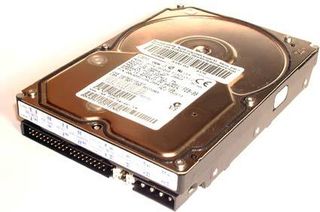IDE Training Course, Part 1: A Detailed Look at the Basics and Technology
Hardware Check: The Proper Cables
Modern drives with UltraDMA/66 or UltraDMA/100 require the use of 80-wire IDE cables. Though they only require 40 of them directly (it's still a 40-wire connection), the other half makes sure that the operation is smooth.

From left to right: 50-wire SCSI-2 cable, 80-wire IDE cable, 34-wire floppy cable.
The purchase of twisted cables is a prudent investment. These offer significantly less resistance to the air that is circulating in the cabinet. They also allow you to get a better look at the inside of a computer that is so equipped.

Left: twisted floppy cable, also available for IDE. Though these cables are expensive, they don't block essential air circulation inside the cabinet.

Dreams of the future: the cable on the left is for Serial ATA. First drives and controllers will be available from dealers as early as this summer.
Connecting And Configuring: You Don't Have To Be A Rocket Scientist
The technical specs are quite simple: there's one master drive and one slave drive per channel. You make the settings with jumpers directly on the drives, which are usually marked clearly nowadays.
While you can use 40-wire cables any way you like, 80-wire IDE cables are different. The connectors are color-coded - blue is the connector for the adapter, the black and gray cables are for the drives. While it is not important where you actually place the master or the slave, you should preferably use the outer connector if you connect only one drive, as otherwise signal reflections may occur.
Stay on the Cutting Edge
Join the experts who read Tom's Hardware for the inside track on enthusiast PC tech news — and have for over 25 years. We'll send breaking news and in-depth reviews of CPUs, GPUs, AI, maker hardware and more straight to your inbox.
The most valuable advice for connecting IDE devices, however, is to always use common sense. For example, you might want to avoid using an old CD-ROM drive in combination with a brand-new hard drive. For some controllers, you still can't rule out the possibility that the total performance may suffer because of very different protocols and transmission capacities.
A Look Back On Performance: From 3.2 To 120 GB
In order to give you a better picture of the fast-paced, albeit often underestimated, development in hard drive capacity, we put various representatives of different generations to the test for you, using a modern system. We included the following drives:
UltraDMA/33: Quantum Fireball ST 3.2A
This drive was our partner in a multitude of hardware tests in all categories at the end of the 90's. Featuring 5,400 rpm and a buffer of 256 kB, it was one of the highlights a little less than five years ago.

The Quantum Fireball ST 3.2A offered the highest performance in 1997 and 1998. Modern operating systems like Windows 2000 or Windows XP, however, lose much of their speed because of these vintage models. For new computers, remember: stay away from old drives.
UltraDMA/33: IBM DTTA351010
The DTTA series from IBM was available with either 5,400 or 7,200 rpm. Sporting a buffer of 512 kB, this drive was populated rather decently, but it was one of the final models before UltraDMA/66 was introduced.

A whopping eight different versions of the Deskstar 16GP were available. The 14GXP was quite similar technologically, and it was also IBM's first IDE family with 7,200 rpm.
UltraDMA/66: Seagate Barracuda ATA (ST320430A)
Seagate's first IDE hard drive with 7,200 rpm went by the name of Barracuda ATA. For today's standards, the drive featuring a 512 kB buffer gets extremely hot and makes a lot of noise - a rough diamond of days gone by, really, quite characteristic of the wild days of the UltraDMA/66.
UltraDMA/100: Western Digital WD1200
Western Digital's high-end drives are still counted among the best to be had in the area of hard drives. The WD1200 with a capacity of 120 GB is available with a buffer of either 2 MB or an impressive 8 MB (1200BB and 1200JB, respectively). Its rotational speed of 7,200 rpm also makes for short access times.

The WD1200 is still one of the fastest IDE hard drives on the market.
Current page: Hardware Check: The Proper Cables
Prev Page Saturated Capacity: Int13h Extensions And LBA Next Page Test ConfigurationMost Popular

